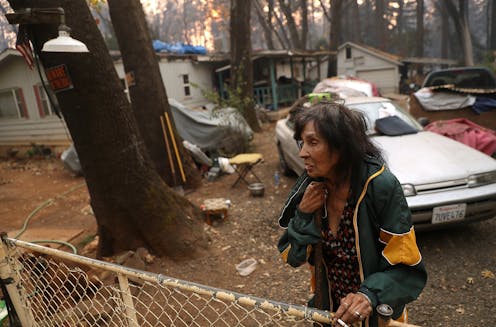Wildfire risk is soaring for low-income, elderly and other vulnerable populations in California, Washington and Oregon
- Written by Mojtaba Sadegh, Associate Professor of Civil Engineering, Boise State University

As wildfires burn across the Western U.S.[1], the people in harm’s way are increasingly those least able to protect their homes from fire risks, evacuate safely or recover after a fire.
In a new study[2], we and a team of fellow wildfire[3] scientists[4] examined who lived within the perimeters of wildfires over the past two decades in Washington, Oregon and California – home to about 90% of Americans in the U.S. West exposed to wildfires over that period.
Overall, nearly half a million people in California, Oregon and Washington were exposed to wildfires at some point during the past 22 years. Alarmingly, about half the people exposed to wildfires in Washington and Oregon were considered socially vulnerable.
While the number of people exposed to fire rose overall, the number of socially vulnerable people exposed more than tripled between the first and second decades.
How social vulnerability affects fire risk
A variety of factors shape social vulnerability[5], including wealth, race, age, disability and fluency in the local language.
These factors can make it harder to take steps to protect homes from wildfire damage, evacuate safely and recover after a disaster. For example, low-income residents often can’t afford adequate insurance coverage that could help them rebuild their homes after a fire. And residents who don’t speak English may not hear about evacuation orders or know how to get assistance after a disaster.
Older adults face rising fire exposure
We found that older adults in particular were disproportionately exposed to wildfires in all three states.
Physical difficulties and cognitive decline can hamper older adults’ ability to keep their properties clear of flammable materials, such as dry shrubs and grasses, and can slow their ability to evacuate in an emergency. The fire that destroyed the town of Paradise, California, in 2018 was a tragic example. Of the 85 victims, 68 were 65 years of age or older.
Poverty was another important factor in the exposure of people with high vulnerability to wildfires in Oregon and Washington.
Finally, including social vulnerability when studying future wildfire trends is important to shape community responses and policies.
Many national disaster prevention programs skew funding toward wealthier communities because they use cost-benefit analyses to direct resources to areas with the greatest potential losses[15]. But while wealthy residents may lose more in dollar value, low-income residents typically lose a larger percentage of their assets and have a harder time recovering[16]. With the rising percentage of people with high social vulnerability at risk of wildfires, governments may need to rethink those methods and lower the barriers for aid[17].
References
- ^ burn across the Western U.S. (www.nifc.gov)
- ^ new study (www.science.org)
- ^ wildfire (scholar.google.com)
- ^ scientists (scholar.google.com)
- ^ social vulnerability (ece.uprm.edu)
- ^ AP Photo/Sam Metz (newsroom.ap.org)
- ^ increasing trends of intense, destructive fires (theconversation.com)
- ^ data from the Centers for Disease Control and Prevention (www.atsdr.cdc.gov)
- ^ Wildfire smoke (theconversation.com)
- ^ risk rises in a warming world (doi.org)
- ^ federal government increased its investment (www.fs.usda.gov)
- ^ near Medical Lake, Washington (www.spokesman.com)
- ^ came close to (www.dshs.wa.gov)
- ^ Justin Sullivan/Getty Images (www.gettyimages.com)
- ^ resources to areas with the greatest potential losses (www.npr.org)
- ^ have a harder time recovering (doi.org)
- ^ lower the barriers for aid (www.americanprogress.org)
Authors: Mojtaba Sadegh, Associate Professor of Civil Engineering, Boise State University


